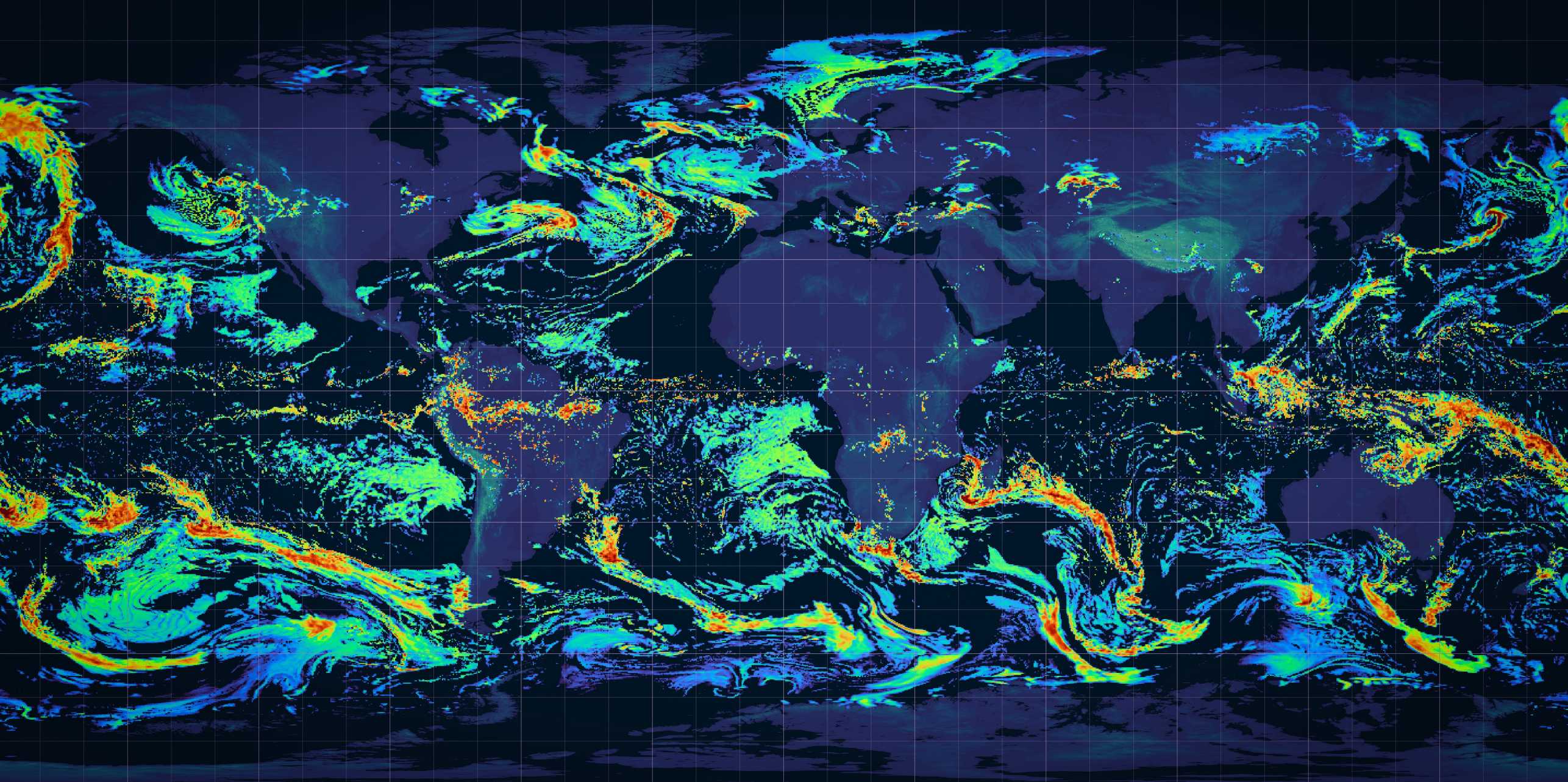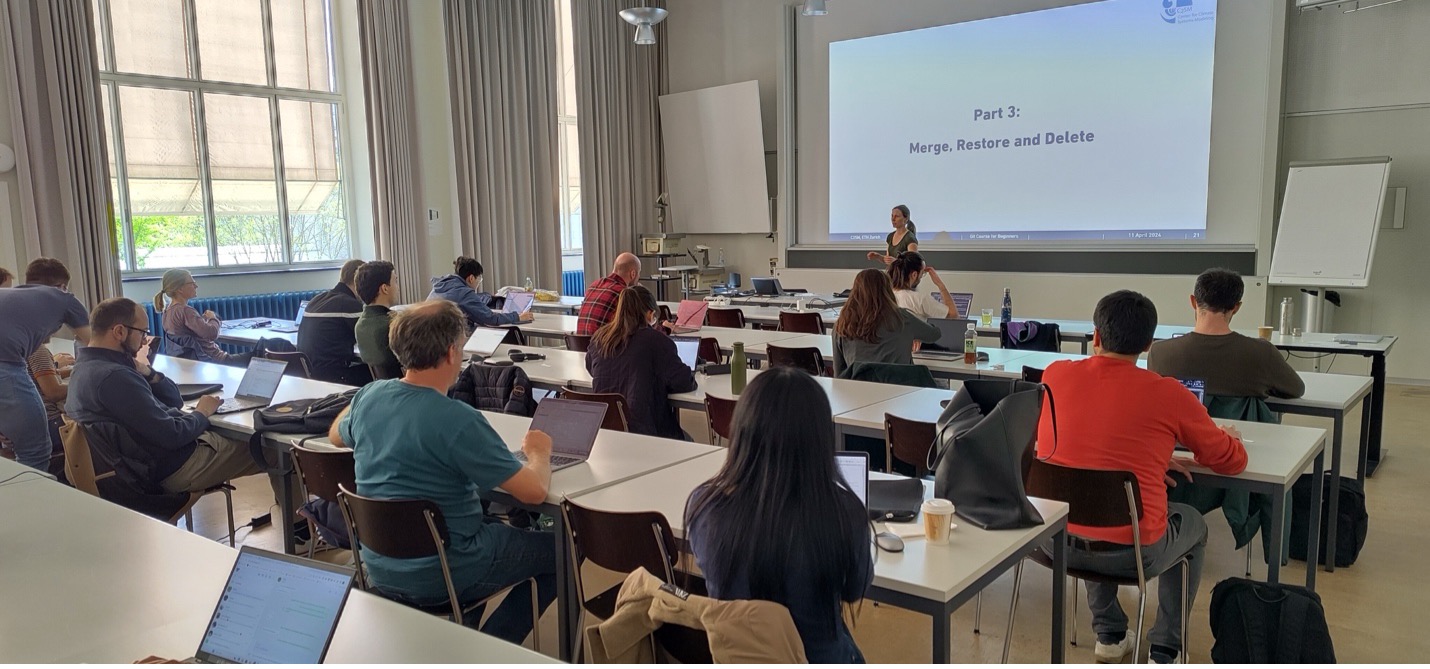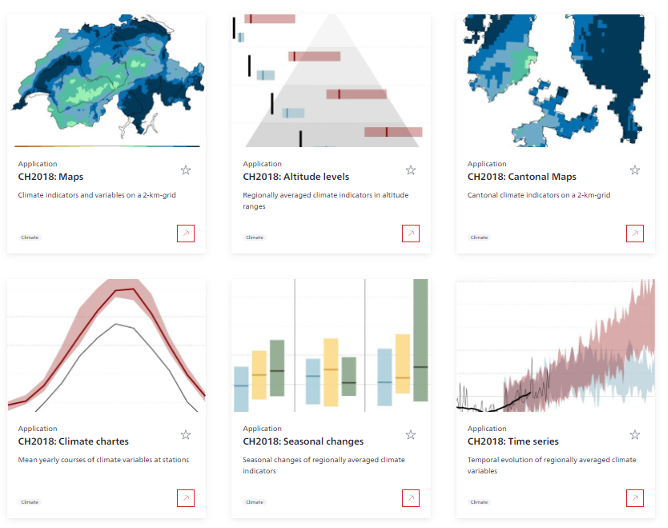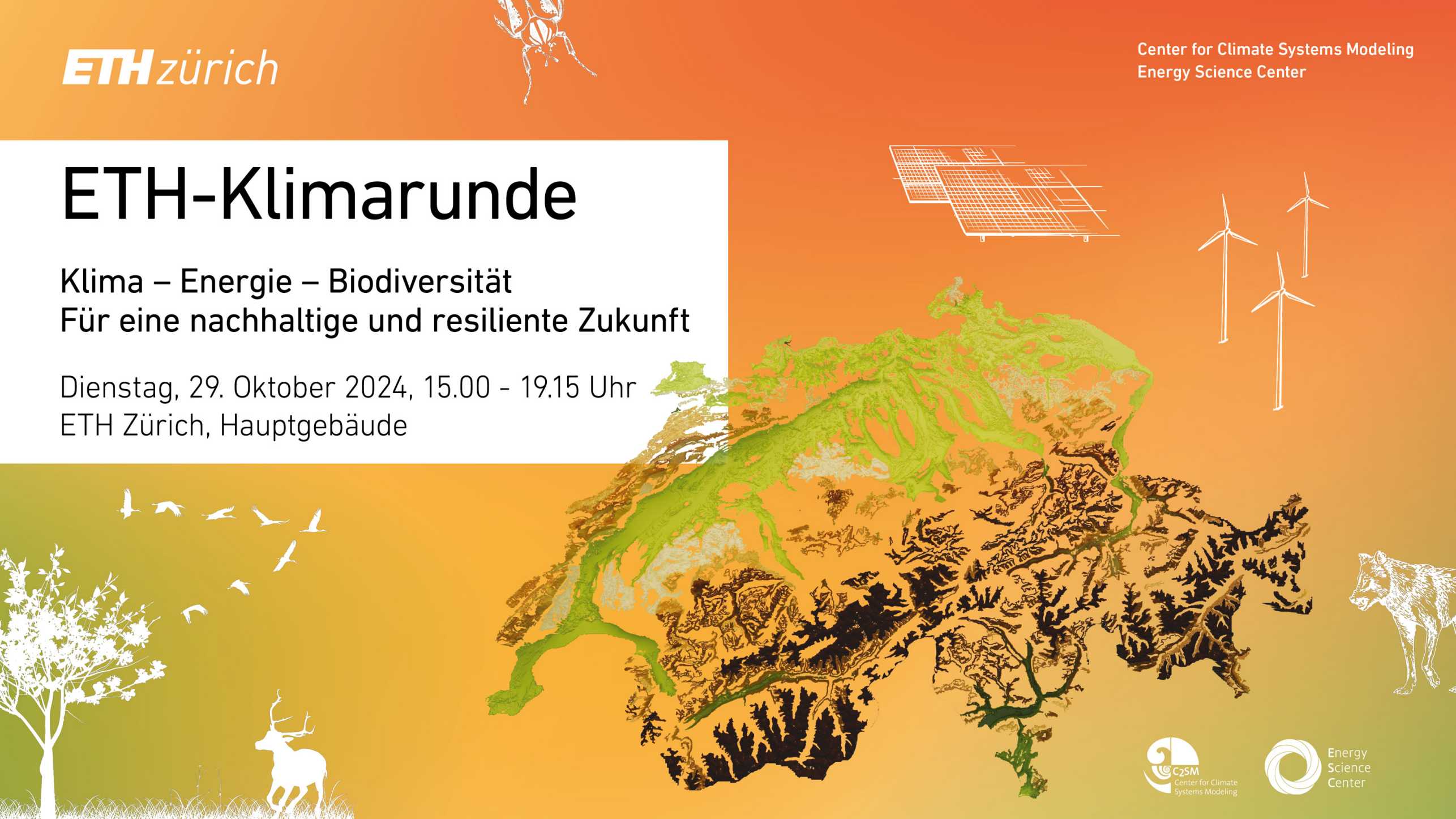C2SM Newsletter Vol. 39
Eawag now partner institution of C2SM
Since April 2024, external page Eawag, the aquatic research institute of the ETH domain, has officially partnered with C2SM as one of its funding institutions. C2SM and Eawag particularly collaborate on data services providing climate model data to their climate impact researchers. In this context, first activities have resulted in the creation of a new C2SM workshop on climate model and climate data for impact research, which was carried out for the first time in December 2023 and is now planned to be carried out on an annual basis. In addition, as our impact researchers do not have access to C2SM’s climate model data directly, C2SM has developed the data extraction tool Zephyr for easy extraction of climate (model) data for individual gridpoints and regions (see 2. Modelling Activities & Services, Working Group 4).
We also welcome Dr. Martin Schmid as representative of Eawag in the C2SM Steering Committee. He was elected to the committee at the 2024 plenary meeting in March. We are thrilled to have Martin on board and are looking forward to many more inspiring collaborations!
C2SM services for the University of Bern
C2SM is happy to announce that it now also offers some of its services to the University of Bern / external page Oeschger Centre for Climate Change Research. Specifically, C2SM has opened its software repositories for a limited number of researchers who apply the ICON (Icosahedral Nonhydrostatic) Weather and Climate Model on the CSCS supercomputers. C2SM also offers technical support with setting up, running and debugging ICON. The University of Bern researchers are now also invited to the three-monthly C2SM ICON meetings, as well as to attend the C2SM working group meetings as guests.
Welcome to Andrea Möller at C2SM
We are delighted to welcome Andrea Möller to the C2SM Core Team as our new Communications Specialist. Andrea studied Earth Sciences at ETH Zurich and has extensive experience in science communication. We wish her a successful start and look forward to working with her. Welcome to the C2SM Core Team!
News flash: C2SM Annual Report 2023
The center’s Annual Report 2023 was released in May and is available at the C2SM website.
The scientific programmers of the C2SM Executive Office, also well-known as C2SM Core Team, receive the majority of their programming tasks from the four working groups of C2SM, which cover the topics of model development, high performance computing, climate scenarios, and climate impacts. Highlights of successfully completed tasks of the past months are described below.
Working Group 1 (WG 1): High Performance Computing
Restructured Experiment and Test Configuration in ICON
With the introduction of the new Alps supercomputer infrastructure, a new continuous integration (CI) testing framework has been adopted, called CSCS-CI, which is based on the widely used external page GitLab Runners. CSCS-CI offers better options to split testing into different stages, like compiling ICON or running individual experiments separately or even allows for caching to speed up build-times significantly. Currently, the ICON consortium primarily uses a different framework called BuildBot for testing, implying that the experiment and test definitions in the ICON (ICOsahedral Nonhydrostatic) weather and climate model have been specifically tailored to this testing system.
To address this, we have undertaken an effort to generalise these definitions by converting them into a standardised configuration format using the human-readable data serialisation language external page YAML. This framework-independent approach now enables relevant test information to be utilised by different testing frameworks, enhancing compatibility and ease of use across various systems. This step is necessary to fully leverage the new opportunities provided by CSCS-CI
Enhancing Probtest Software for a More Reliable GPU Transition
The ICON model, originally developed for CPUs, is being adapted for GPUs. The external page probtest software verifies that results from CPU and GPU runs are consistent within a specified range around a reference CPU run, which is determined using multiple CPU runs with slightly varied (perturbed) input data.
Due to high computational costs, the number of CPU runs is limited, which sometimes leads to a range that doesn’t cover all possible scenarios. Instead of using a standard set of perturbation seeds, the improved software now automatically selects specific perturbation seeds for the CPU runs, ensuring better coverage of the entire range. This automated method is more stable than the previous manual process, reducing the number of CPU runs needed and lowering computational costs. Additionally, it has effectively eliminated false failures in probtest, making the testing process more efficient. The probtest software is being used on a daily basis by ICON developer, so this implementation speeds up the developing process.
GPU Port for Reading in Transient Aerosol Datasets in ICON
For the regional setup of ICON in climate mode (CLM) (see also WG3: Climate Scenarios), the reading in and processing of time-varying (transient) aerosols needed to be ported to GPU. The dataset used was originally developed by Stefan Kinne at MPI for Meteorology in Hamburg (the so-called "Kinne" dataset) and consists of natural aerosols, MACv2 simple plumes for anthropogenic aerosols and volcanic aerosols.
While this task has been going on since January 2024, we detected a bug in the main version of the ICON code that interrupted our porting efforts. Now, in collaboration with Deutscher Wetterdienst (DWD), this bug has been fixed and we have finalised the GPU port.
Transitioning to the new Alps system
Since quite some time now, the Alps system has been growing at CSCS. First rather silently and now approaching full deployment. Alps is not only about new hardware, as one would naturally expect. It first is a new HPC infrastructure managed in a novel way. It consists of several versatile Clusters (vClusters), managed separately and dedicated to different scientific communities. Then a second level of modularity is achieved with the user environments (uenvs). In place of the old large and convoluted operating system (OS), a close to bare bones unix OS is installed, on top of which uenvs can be activated, which gather the software stack required for specific activities.
All these changes have kept us busy not only adapting the way we build, run and test our supported software with a strong focus (to say the least) on ICON but also preparing the transition of our users by documenting the new procedures and organizing a dedicated workshop in August.
Working Group 2 (WG 2): Development of Weather and Climate Models
Enable output of uncorrected radiative fluxes in ICON
ICON corrects radiative fluxes over complex terrain to better forecast radiative heating. This correction is not helpful for downstream models that itself apply a correction of radiative fluxes. To enhance integration for these downstream models, ICON now provides both uncorrected instantaneous and uncorrected time-averaged radiative fluxes as output variables. By offering these outputs, downstream models, especially those focusing on glacier and snow simulations, can streamline their processes without needing to reverse ICON's corrections beforehand. This facilitates more accurate and efficient modelling of local valley wind systems and other terrain-dependent phenomena.
Working Group 3 (WG 3): Climate Scenarios
ICON-CLM in EURO-CORDEX Setup
One of the use cases of the EXCLAIM (see below) project focuses on conducting regional climate simulations over Europe, employing the GPU version of ICON-CLM, where CLM stands for Climate Limited-area Modelling. Currently, final steps are being taken to prepare a full evaluation simulation, a historical, as well as a scenario simulation contributing to the EURO-CORDEX balanced matrix.
The CLM Community has published their final modelling setup that will be used across groups for all EURO-CORDEX simulations for the 12 km domain. This includes the latest public release of ICON (2024.07), as well as a specific set of namelist settings as a result of several evaluation studies and tuning efforts.
To enable this setup to run on GPU, further components of the ICON code must undergo GPU porting. These are transient ozone climatology, solar irradiation for climate simulations, using MODIS climatology to represent the cloud-droplet number concentration, and the diagnostic boundary layer height output. The first simulations will start once these components are ported to GPU and as soon as the new Alps infrastructure is ready.
In the past, we have already ported other necessary parts of the code, such as the usage of instantaneous sea-ice fraction and sea-surface temperature fields, upper boundary nudging and the reading-in process for the transient aerosol data to be compatible with GPU architecture.
Klima CH2025
The C2SM Core Team supports the Klima CH2025 project (see below) in several ways. On the science side regional climate model simulations (EURO-CORDEX RCMs) were thoroughly evaluated, and a selection was made which simulations to use for the Swiss climate scenarios CH2025. Criteria include resolution, if the simulations include transient aerosols and if they have already been verified for CH2018. The simulations are still driven by global circulation models from CMIP5 (CMIP6 based runs are not available yet), as in CH2018, but a larger number of simulations is available than for CH2018. The selection also had an eye on historical warming, which tends to be underestimated in these RCM simulations, and favoured simulations with realistic warming rates.
On the technical side, we have added additional variables to the climate data archive, like surface wind speed and evaporation. The archive includes both historical and future climate data from the EURO-CORDEX RCMs. We have ensured that all the models are on the same grid and cover the same time period, although some data is missing towards the end of the century (2099). Another important step was to improve the software which processes this data, which now runs faster and more reliably. In August, we released an updated version of the data (freeze1.1) that includes the new variables and also fixes a minor error in one of the model datasets.
Working Group 4 (WG 4): Climate Impacts
Climate Data Extraction Tool Zephyr
A key request from researchers who study the impacts of climate change is to have easy access to standardised climate data. While some researchers can directly access the C2SM data servers, many others cannot, e.g., those at WSL and Eawag. Additionally, these researchers often do not need full datasets but just specific parts, like data for certain locations or time periods. To address this, we have developed a web tool called "Zephyr," which we launched in July 2024. Zephyr lets users select the exact data they need—such as specific climate models, time periods, and locations—by drawing on a map or entering coordinates. Once a request is submitted through GitHub, users receive an email when the data is ready to download. Try it out yourself! You can access Zephyr at https://zephyr.ethz.ch/.
Seasonal forecast data from ECMWF
We have added SEAS5 seasonal forecast data to the C2SM archive. SEAS5 is a seasonal forecasting system from ECMWF that provides "hindcasts" (re-forecasts of past weather conditions) which can be compared to historical data to help validate future predictions. We downloaded several variables, such as temperature, precipitation, runoff or sea level pressure and converted them to daily data when needed. Initially, this data will be used by Manuela Brunner's HYCLIMM group to study forest fires and by Reto Knutti's CLIMPHYS group to analyse temperature extremes. However, this data will also be useful for a wide range of future studies in hydro-climate extremes and hydrological forecasting (more info about SEAS5 can be found on the external page ECMWF website).
Compressing scClim regional climate model run data
The SNF scClim project (Seamless coupling of kilometre-resolution weather predictions and climate simulations with hail impact assessments for multiple sectors, https://scclim.ethz.ch/) has produced large model output from simulations with the COSMO model including hail output at 5 minute intervals in addition to hourly and daily variables like precipitation, temperature, radiation etc. To save storage space, this data needed to be compressed and moved to another storage location at CSCS. The challenge of this task was the large amount of data and the large number of files. We have now compressed this data successfully, and moreover, have been able to automatise the procedure to a large degree such that we are now well prepared for similar tasks in the future.
Cropping hourly ERA5-land precipitation data to a large number of river catchments
For a project in Manuela Brunner’s group, which investigates the role of weather patterns and precipitation characteristics in driving rapid drought to flood transitions, hourly precipitation data from ERA5-land needed to be cropped and then averaged over river catchment areas. This implies a single value per river catchment per time step. While the data in the result is small, the data to be processed (global, 0.1° x 0.1° spatial resolution, hourly) is big and the number of catchments is very large (~6000). Therefore, we supported Manuela’s group in getting this data processed on the ETH cluster Euler in an efficient manner using multiprocessing.
Technical Courses «Git for Beginners» and «Git for Advanced» Successfully Carried Out
In April 2024, we organised the "Git for Beginners" workshop at ETH again. The workshop was designed to introduce version control systems (with the focus on Git) and common workflows to those with little to no experience. It was attended by 20 participants from various member groups (IAC, WSL, WCR, and others), featured slides and hands-on Git exercises.
All course materials are available online for review and practice. Participants found the workshop informative, practical and well-organised with valuable insights into efficient usage of version control systems.
The follow-up workshop “Git for Advanced” took place on 25 September 2024. 14 participants attended this course to deepen their knowledge in advanced Git commands as well as learning about the workflow in collaborative projects. More information is available on our website.
Climate model and climate data workshop – Save the date: 21 November 2024
We will again run a "climate model and climate data workshop for impacts researchers" towards the end of the year. This year we will run the workshop at ETH on 21 November. In case you are interested, save the date. More information will follow closer to the date. Please check our webpage for updates.
The EXCLAIM project (Extreme scale computing and data platform for cloud-resolving weather and climate modelling) aims to develop an ICON-model based infrastructure that is capable of running kilometre-scale climate simulations at both regional and global scales.
EXCLAIM, together with CSCS, has achieved significant milestones in the past months towards transitioning to the new Alps infrastructure at CSCS. ICON with the GT4Py dynamical core runs successfully on the new Nvidia Grace-Hopper 200 (GH200) superchips. The gain in throughput is roughly 8 times compared to that of P100 on Piz Daint. In terms of the scientific use cases, the model was successfully evaluated for global aquaplanet and prescribed sea surface temperature (SST) simulations at 5 km and 10 km horizontal grid spacings, respectively. Efforts are ongoing to make the model run stably at 1.25 km (for global aquaplanet) and 5 km and 2.5 km for the prescribed SST use case. Thanks to the efforts from the PIs engaged with EXCLAIM and the team, the model is also capable to use the JSBACH land-surface scheme in addition to TERRA.
Latest EXCLAIM publications:
Canton, J., and A. Dipankar (2024): Climatological analysis of urban heat island effects in Swiss cities, Int J Climatol, 4, external page https://doi.org/10.1002/joc.8398
Goger, B., and A. Dipankar (2024): The impact of mesh size, turbulence parameterization, and land-surface-exchange scheme on simulations of the mountain boundary layer in the hectometric range, Q J R Meteorol Soc, 150, external page https://doi.org/10.1002/qj.4799
Klima CH2025
The external page Klima CH2025 team marked the halfway point of the project with a one-day retreat at the EPI Zentrum overlooking Lake Zurich. Updates from all Working Groups and poster presentations were shared and goals set for the Autumn 2024 phase. Specifically, the drafting process for the Scientific Report begins in September 2024 and will run through to early 2025. Alongside the scientific work, good progress is being made into developing the design and communication aspects of the Project. We thank everyone for their hard work so far and look forward to a busy Autumn.
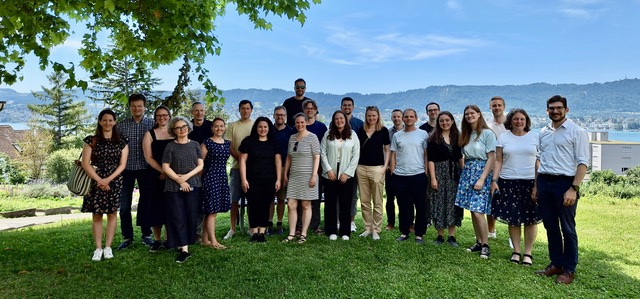
Update: CH2018 web atlas in new design
The CH2018 web atlas, being the interactive and user-friendly web platform for the distribution of the CH2018 climate scenario products, has been updated with a new design. It is now integrated into the MeteoSwiss Product Browser and its look-and-feel is consistent with other MeteoSwiss products. The web atlas provides a direct access to the CH2018 graphics and data, and covers all regions and locations, all seasons, all future time periods and all emission scenarios for which calculations are available. Exploring the results of CH2018 should now be even easier:
- external page CH2018 web atlas on the NCCS website
- external page CH2018 web atlas at the Applications website of MeteoSwiss (insert, for instance, “CH2018” into the search field)
SANTA is coming
The SANTA project (Spatial snow cover projections for Switzerland) aims to generate high-resolution (1km2) spatial snow cover projections across Switzerland under the Klima CH2025 framework. Harsh Beria, a project scientist working jointly at SLF (Team Snow Processes) and MeteoSwiss (Team Climate Evolution), has now started his two-year appointment. For the first time, detailed snow water equivalent (SWE) and snow depth maps will be produced for entire Switzerland for different global warming levels. These snow projections will use the Klima CH2025 bias-adjusted GCM-RCM model runs as atmospheric forcing.
The project will also provide key snow indicators tailored to different end-users, such as snow cover duration, snow fraction or snow disappearance date. Additionally, SANTA will investigate the benefit of applying energy-balance snow models instead of the current degree-day snowmelt approach used for the above projections. This collaboration between SLF and MeteoSwiss builds on their continued partnership in snow research and is facilitated by C2SM. More to come soon…

Sixth consortium within NCCS-Impacts has been confirmed
In August 2024, the RECIPE (Resilient Infrastructure for the Swiss Energy Transition) consortium has been confirmed as the sixth NCCS-Impacts project. The consortium members at ETH Zurich, EPFL, Swisscom, Infras, University of Applied Sciences Northwestern Switzerland, Lucerne University of Applied Sciences and Arts and zoï Environment Network will address the technical, natural and societal hazards of critical infrastructure to investigate the resilience of the Swiss energy system in the age of climate change.
RECIPE is the final amongst six cross-sectoral and interlinked projects that are being implemented under the umbrella of NCCS-Impacts. The programme develops actionable climate services for the environment, economy and society.
Further information on NCCS-Impacts is available external page here.
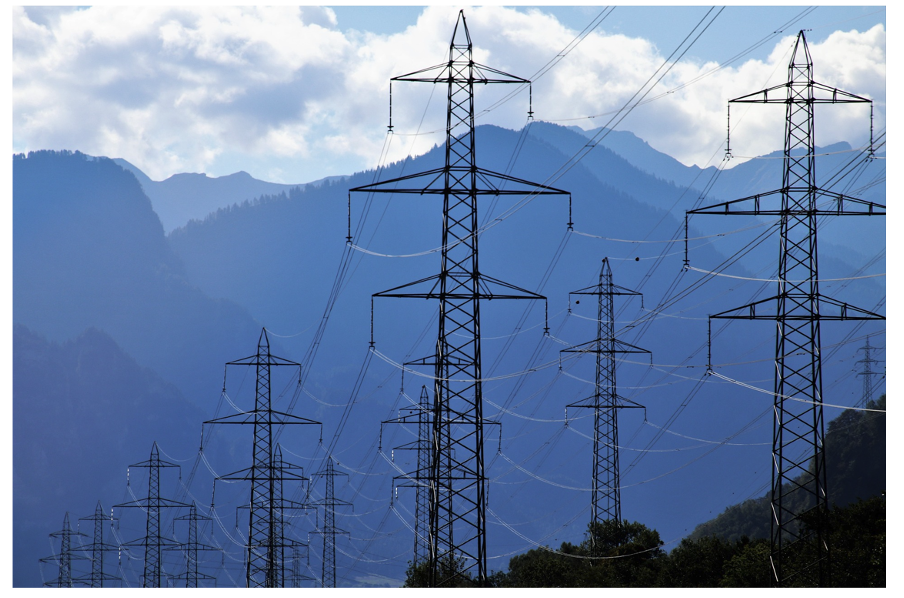
Simons Foundation Funds GLANCE (Glaciogenic seeding on mixed-phase clouds for radiation management)
Solar and terrestrial radiation management is a climate intervention approach to modify the Earth's radiation budget by cooling the planet and mitigating some of the negative impacts from global warming. As a new alternative to solar radiation management proposals such as stratospheric aerosol injection, terrestrial radiation management has the potential to also mitigate polar warming during winter. In particular, a new method of mixed-phase cloud thinning (MCT) has recently been proposed, based on seeding supercooled liquid clouds with ice-nucleating particles (INPs). This causes these clouds to glaciate and precipitate, allowing more longwave radiation to be emitted to space. However, cloud glaciation is still poorly represented in climate models, so the risks and potential of this and other INP-based climate solutions remain uncertain. GLANCE project with PI Ulrike Lohmann, running from May 2024 until April 2027, aims to improve our understanding of cloud glaciation and MCT in order to increase our range of options in the event of a climate emergency and to minimise their potential risks. It is one of total 14 projects exploring earth-cooling techniques that are funded by the external page Simons Foundation as part of a new international external page research programme on the Solar Radiation Management.
Dr Sünje Dallmeier-Tiessen joins MeteoSwiss as Head of Division Development of Prognosis (SEP)
Sünje studied Geosciences and earned her doctorate in Information Science. The last decade she was senior staff at CERN (Geneva). There she set up various initiatives and services in the field of Open Science, Open Data and reproducible research. She lead larger project and development teams, including setting up and managing the CERN Open Science Office, and the associated personnel management. She has practical experience in agile project management and third-party funding acquisition.
She is now leading “SEP” at Meteo Swiss, the division called “Prognoseentwicklung”, which is responsible for developing and operating tools and services to deliver prognosis (tools) and warnings. Many of the developments are done in collaboration with other institutions, such as ETH. She can be reached .
ETH-Klimarunde 2024 - Registration open
"Climate - Energy - Biodiversity. For a sustainable and resilient future."
Tuesday, 29 October 2024, from 15:00 to 19.15 h at ETH Zurich, main building. The lectures and the podium discussion (all in German) will also be livestreamed.
Learn more about the programme and register now online on our website!
Save the date for these upcoming events:
Energy Week @ ETH: 4-8 November 2024
The Energy Science Center (ESC), competence center of ETH Zurich for energy research and education, will hold its annual energy conference, the “Energy Week @ ETH” for the eighth time in 2024. More information can be found on: https://energyweek.ethz.ch/
Swiss Climate Summer School: 24-29 August 2025
The 23rd Swiss Climate Summer School focuses on the theme “Sustainable pathways to net zero" and will take place at Monte Verità in Ascona (Ticino). This summer school addresses early stage researchers from climate and earth system sciences to biodiversity, energy, social, political, and economic sciences. Detailed information and the application will be available from early November at: external page https://climateresearch.ch
We congratulate Emilie Fons on her successfully completed her PhD on 30 May 2024 on "Using causal inference to disentangle areosol-marine low cloud interactions".
- external page How trees 'talk' to each other
Prof. Tom Crowther, thenakedscientists.com, 18.06.2024
- external page Ozeane im Ausnahmezustand
Prof. Nicolas Gruber, SRF, Wissenschaftsmagazin, 08.06.2024 - external page Sauberere Luft führt zu wärmeren Sommern in Europa
Prof. Erich Fischer, Blick.ch, 13.04.2024
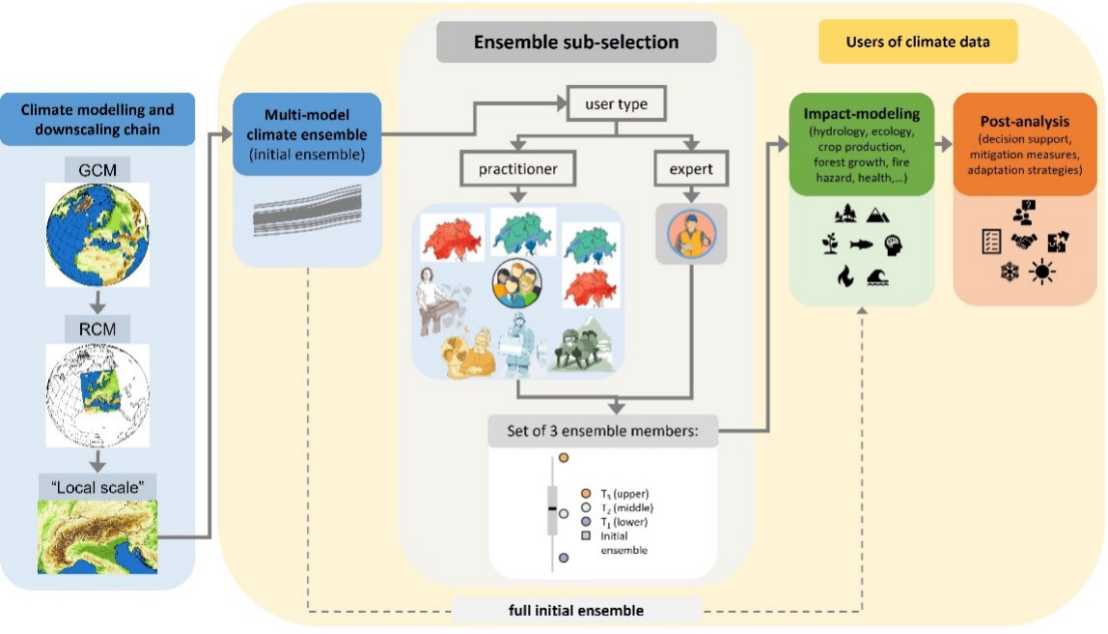
Climate model ensembles provide input to impact studies that use sector-specific models (e.g., hydrological, crop models, fire hazard) at regional or local scales. These models require regionally scaled climate information to simulate the potential environmental and socio-economic sectoral impacts of climate change. However, they often cannot consider the full original climate model ensemble, and a sub-selection of representative climate model ensemble members is required.
In a new work that has recently been published, the Climate Evolution team of MeteoSwiss presents a novel user-tailored method for sub-selecting climate model ensemble members for seven pre-defined application cases and one expert case over the Swiss domain. The selection procedure is based on the ranking of the climate change signal (CCS) calculated for a set of climate indices. Based on the strength of the CCS, three ensemble members representing the strongest, weakest, and median CCS are selected for each application and each emission scenario. The regional results of the presented ensemble selection based on the external page CH2018 Climate Change Scenarios will soon be made available to users via a dedicated NCCS website and via the CH2018 webatlas. More information about this will follow in the next C2SM newsletter.
Sikorska-Senoner, A. E., J. Rajczak, M. Zappa, and S. Kotlarski (2024): User-tailored sub-selection of climate model ensemble members for impact studies, Science of The Total Environment, 175769, external page https://doi.org/10.1016/j.scitotenv.2024.175769
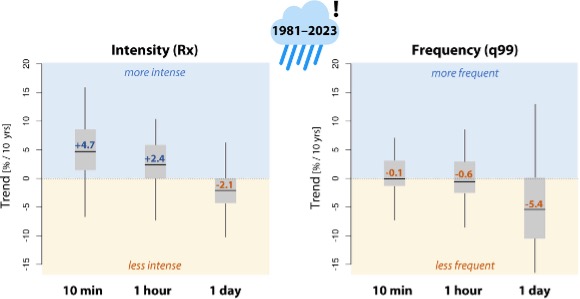
Heavy precipitation is a major natural hazard in the Alps, and understanding its potential changes due to climate change is crucial for effective adaptation strategies. This study investigates trends in intensity and frequency of heavy precipitation using MeteoSwiss station data for the period 1901 to 2023. The main findings are:
- daily maximum precipitation and the frequency of moderate extreme events have increased since 1901
- short-duration events (10-min to 3-h) have increased in intensity since 1981, especially in summer, but these events have not become more frequent
- longer events (1- to 5-days) have decreased in intensity and frequency since 1981, especially in winter
The study suggests that these trends result from the interaction between human-induced climate change and atmospheric variability. The data also suggest a small, but overall insignificant, elevation dependence of these trends. Overall, the results underscore the need to further investigate the interplay between climate change, internal variability of large-scale dynamics and elevation to better understand heavy precipitation variability in the complex Alpine terrain.
Bauer, V. M. and S.C. Scherrer (2024): The observed evolution of sub‐daily to multi‐day heavy precipitation in Switzerland, Atmospheric Science Letters, external page https://doi.org/10.1002/asl.1240
Effective realisation of abatement measures can reduce HFC-23 emissions
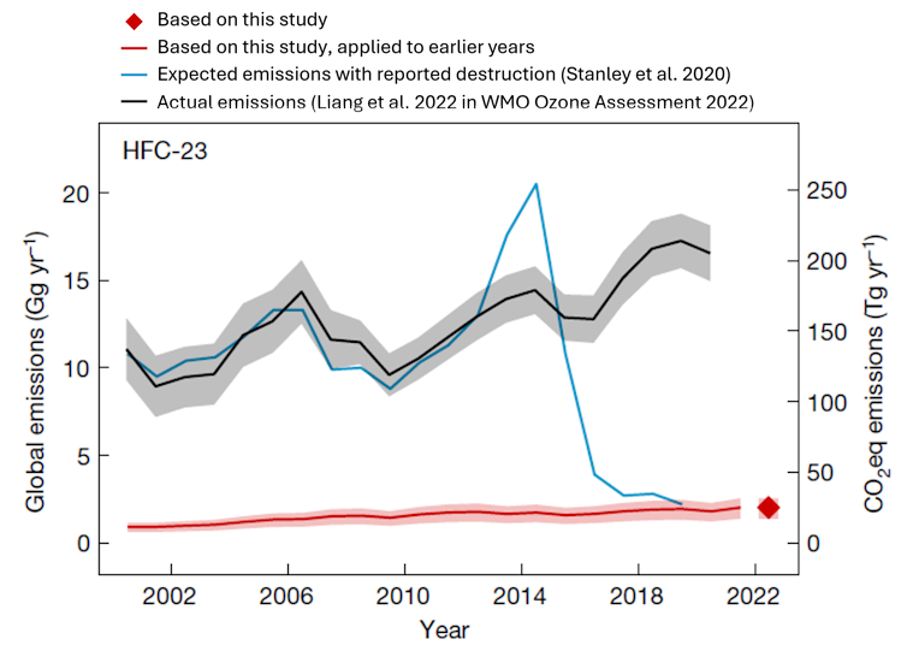
Trifluoromethane (CHF3, HFC-23) is one of the most potent greenhouse gases (GWP100: 12'400), mostly emitted to the atmosphere as a by-product during the production of the refrigerant and feedstock HCFC-22 used for Teflon production. The Empa study by Rust et al. shows that CO2-equivalent emissions of the size of one fifth (17%) of (pre-COVID pandemic) global aviation (equivalent to ~170 Tg CO2 yr-1) could be prevented if all production facilities worldwide implemented HFC-23 destruction technologies properly. According to the 2016 Kigali Amendment to the Montreal Protocol, factories must destroy this greenhouse gas to the "extent practicable". Empa conducted a tracer release experiment to determine the total (stack + leakage) emissions of a fluoropolymer plant in the Netherlands. On several suitable days, a controlled amount of a reference tracer was released close to the facility and the concentrations of the emerging plumes were measured 25 km downwind at the ICOS tall tower site Cabauw. From the observed concentration ratios the emitted amount of HFC-23 and other by-products could be estimated. Results showed that at this facility destruction technology was working efficiently and a high degree of HFC-23 abatement was achieved. Upscaling the obtained emission factors to global production shows that current global HFC-23 emissions could be reduced by at least 85%, if all industries abated HFC-23 to the extent achieved in the Netherlands.
Rust, D., M. K. Vollmer, S. Henne, A. Frumau, P. van den Bulk, A. Hensen, K. M. Stanley, R. Zenobi, L. Emmenegger, and S. Reimann, S. (2024): Effective realization of abatement measures can reduce HFC-23 emissions, Nature, external page https://doi.org/10.1038/s41586-024-07833-y
More papers worth reading:
Battista Cavadini, G., M. Rodriguez, T. Nguyen, and L. M. Cook (2024): Can blue–green infrastructure counteract the effects of climate change on combined sewer overflows? Study of a swiss catchment, Environ. Res. Lett., 19, 094025, doi: 10.1088/1748-9326/ad6462, external page https://iopscience.iop.org/article/10.1088/1748-9326/ad6462/meta
Fischer, A. M., J. Bessembinder, F. Fung, H. O. Hygen, and K. Jacobs, K., eds. (2024): Generating actionable climate information in support of climate adaptation and mitigation, Lausanne, Frontiers Media SA, doi: 10.3389/978-2-8325-5140-0, external page https://www.frontiersin.org/research-topics/22610/generating-actionable-climate-information-in-support-of-climate-adaptation-and-mitigation/overview
Geiger, T., T. Röösli, D. N. Bresch, B. Erhardt, A. M. Fischer, D. Imgrüth, S. Kienberger, L. Mainetti, G. Mühlbacher, and R. Spiekermann (2024): How to provide actionable information on weather and climate impacts? – A summary of strategic, methodological, and technical perspectives, Front. Clim., 6, 1343993, external page https://doi.org/10.3389/fclim.2024.1343993
Mani, P., S. Allen, S. Kotlarski, and M. Stoffel (2024): Climate sensitivity of natural hazards processes in mountain regions: A fuzzy logic approach, Geomorphology, 461, 109329, external page https://doi.org/10.1016/j.geomorph.2024.109329.
Matiu, M., A. Napoli, S. Kotlarski, D. Zardi, A. Bellini, and B. Majone (2024): Elevation-dependent biases of raw and bias-adjusted EURO-CORDEX regional climate models in the European Alps, Climate Dynamics, external page https://doi.org/10.1007/s00382-024-07376-y
Schilliger, L., A. Tetzlaff, Q. Bourgeois, L. F. Correa, and M. Wild (2024): An investigation on causes of the detected surface solar radiation brightening in Europe using satellite data, Journal of Geophysical Research: Atmospheres, 129, e2024JD041101, external page https://doi.org/10.1029/2024JD041101

